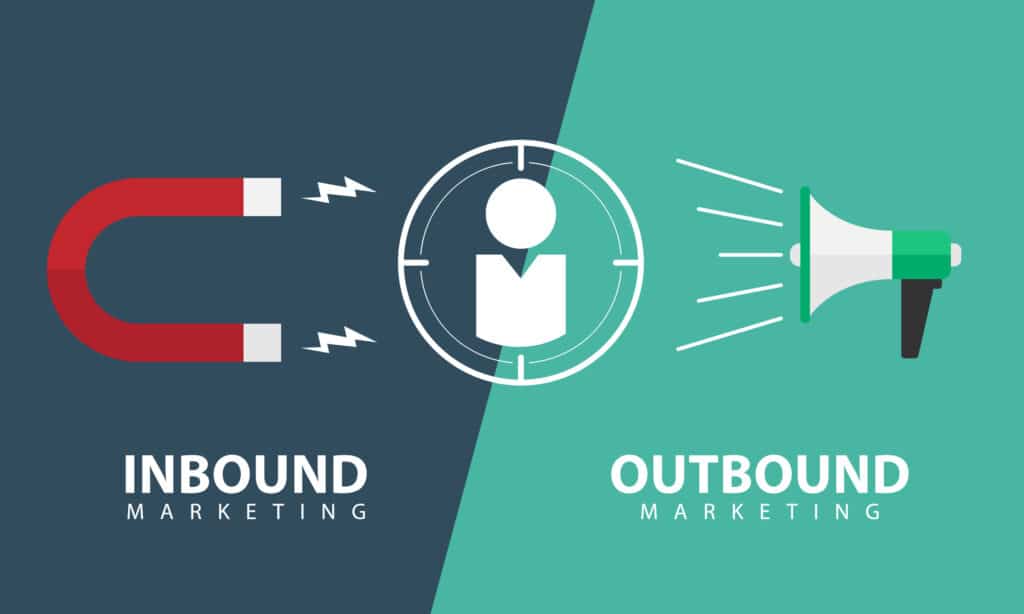Inbound and outbound marketing are both powerful services for successful lead generation, but they accomplish this success in different ways. Is one more important than the other? Not necessarily. Think of them as two halves to your overall digital marketing strategy. Read on to learn what’s involved with each, how they differ, and how they benefit your prospecting.
Inbound Marketing
The main difference between inbound and outbound marketing is where their leads come from. Inbound marketing is about encouraging leads to go to you, rather than you trying to go to them. So how do you do that?
Website. Make sure that your website is easy to navigate, includes relevant content that answers the questions your leads have about your products and services, and ultimately prompts them to buy from you. It’s also important that your leads can find your website, so inbound marketing is about SEO.
SEO. You want leads to see your company when they perform a Google search. The closer you are to the top of those results, the better your chances of being clicked. This requires you to be strategic with your content to create a positive website ranking.
How?
Keywords are an excellent start. Understand which ones are appropriate to you, your industry, and — most importantly — your customers. Use them enough that they rank specific pages, but not so much that Google thinks you’re keyword stuffing.
Content length can also be an influence. While the jury’s still out on exactly how many words a blog post should be, you’re better off paying for a keyword tool that analyzes content that’s currently ranked, then calculates the approximate word count, related keywords, and possible backlinks you can use to establish yours.
Note: This word total will always be a moving target, so content should never be considered a one-and-done deal. Repurposing your evergreen content can help offset this workload.
Pay-Per-Click (PPC) Ads. Unlike SEO, PPC isn’t about ranking at the top of Google results — it’s about being the ad above them. Since most people generally don’t notice the difference between the first search result and an ad on Google, this can certainly benefit your visibility and click-through rates. But keep in mind that if you ever decide to stop this service, your company’s information will immediately disappear from those ad spaces. The bottom line: make sure that you have relevant content to boost your ranking even if you use PPC.
Social Media. People love to post, like, and subscribe. Give them reasons to include your business in that mix by honing your brand and consistently promoting it. Posting images, sharing industry articles, and incorporating video like UGC (user-generated content) are all options for engaging with your target audience.
Another distinction between inbound and outbound marketing is the amount of work involved. Inbound typically requires more effort (as evidenced by the factors above), while outbound is often easier, and the one that people tend to focus on more. Why?
Because it’s all about email.
Outbound Marketing
Email marketing is alive and well, whether you’re using it to prospect for new leads or nurture your existing database of contacts. It’s often the go-to method for a lot of businesses to try and drum up conversations, because it’s the familiar type of “go out and get ’em” strategy that’s evolved from cold calling.
So what all does this involve?
Prospecting Emails and Prospecting Automation. These are the first-touch messages you send to new leads, both to verify you’re contacting the right people, and to learn more about their respective businesses. They’re brief in nature and often minimal in terms of design (not heavy on links or images so that they can avoid spam filters). There are a few different types of prospecting emails that we recommend you use so that you stay top of mind for your leads without the risk of turning them off.
Finding and verifying email addresses for new leads can be a challenge. This is especially true when you consider that leads lists are often outdated, and third-party cookies may soon be a thing of the past. Prospecting automation can fill this need, all while protecting your website domain’s reputation.
Marketing Emails and Marketing Automation. These are probably the emails you’re most familiar with. They tend to be more about brand self-promotion, often utilizing images and links in their messaging. These go out to leads who have engaged with you the most, and who you may have already qualified.
Similar to prospecting automation, marketing automation is available that will deliver these messages for you, and track KPIs to measure their effectiveness.
Why Do You Need Both Inbound and Outbound Marketing?
We recommend that you leverage both halves of digital marketing for one simple reason: they offer multiple ways to funnel leads to your business. You want as many options as you can for keeping your pipeline moving. Prospecting alone won’t cut it. Neither will cold calling or blogging. But use these tools as part of a cohesive strategy, and the results will be obvious.
Want help developing your own inbound and outbound marketing? Click the link below to schedule a free consultation.





